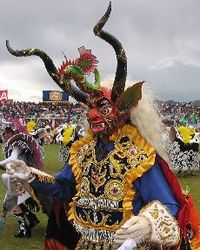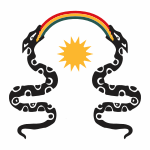Supay
This articlerelies largely or entirely on asingle source.(November 2016) |

In theQuechua,Aymara,andIncamythologies,Supaywas both thegodofdeathand ruler of theUkhu Pacha,the Incanunderworld,as well as a race ofdemons.Supay is associated withminers' rituals.
With theSpanish colonization of the Americas,Christian priests used the name "Supay" to refer to the ChristianDevil.However, unlikeEuropeansin relation to the Christian Devil, "the indigenous people did not repudiate Supay but, being scared of him, they invoked him and begged him not to harm them".[1]
Supay acquired asyncreticsymbolism,becoming a main character of thediabladasofBolivia(seen in theCarnaval de Oruro),Peruand other Andean countries. The name Supay is now roughly translated intodiablo(Spanishfor devil) in most Southern American countries. In some of them, for example the northern region of Argentina, the underworld where Supay rules, is called "Salamanca".
In some areas of Peru, theQuechua peoplecontinue the tradition of the Supay dance at the colonialMamacha Candichafestivity which roughly translates as "virginof the candle flame "known as"Virgen de la Candelaria"in Spanish and is a festival with dancing lasting up to two weeks. However, thedanceof the Supay may be performed for tourists on other occasions not necessarily related toMamacha Candicha.
See also
[edit]References
[edit]- ^"El indígena no repudiaba al Supay sino que temiéndole, lo invocaba y rendía culto para evitar que le hiciera daño". Cuentas Ormachea, Enrique (1986). "La Diablada: una expresión de coreografía mestiza del altiplano del Collao",Boletín de Lima,Nº 44, p. 35, Lima.

